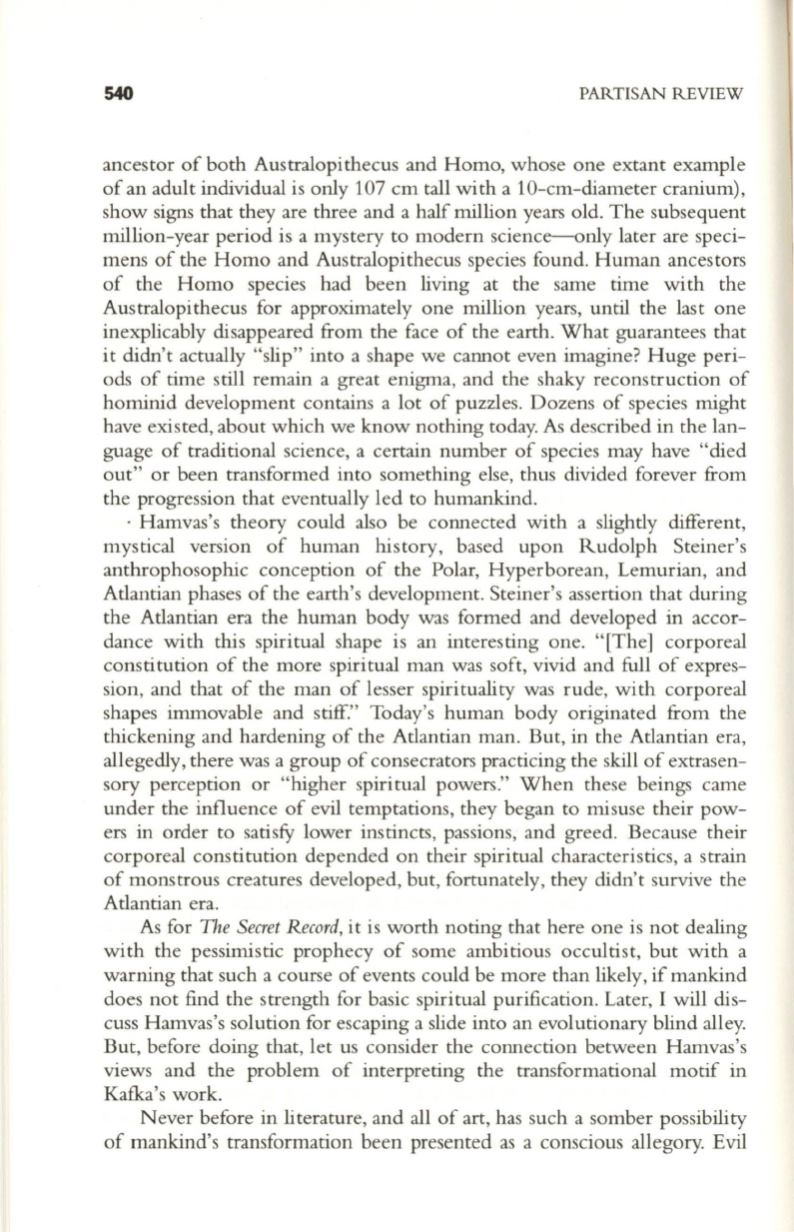
540
PARTISAN REVIEW
ancestor of both Australopithecus and Homo, whose one extant example
of an adult individual is only 107 cm tall with a 10-cm-diameter cranium),
show signs that they are three and a half million years old. The subsequent
million-year period is a mystery to modern science--only later are speci–
mens of the Homo and Australopithecus species found. Human ancestors
of the Homo species had been living at the same time with the
Australopithecus for approximately one million years, until the last one
inexplicably disappeared from the face of the earth. What guarantees that
it didn't actually "slip" into a shape we cannot even imagine? Huge peri–
ods of time still remain a great enigma, and the shaky reconstruction of
hominid development contains a lot of puzzles. Dozens of species might
have existed, about which we know nothing today. As described in the lan–
guage of tradi tional science, a certain number of species may have "died
out" or been transformed into something else, thus divided forever from
the progression that eventually led to humankind.
. Hamvas's theory could also be connected with a slightly different,
mystical version of human history, based upon Rudolph Steiner's
anthrophosophic conception of the Polar, Hyperborean, Lemurian, and
Atlantian phases of the earth's development. Steiner's assertion that during
the Atlantian era the human body was formed and developed in accor–
dance with this spiritual shape is an interesting one. "[The] corporeal
constitution of the more spiritual man was soft, vivid and full of expres–
sion, and that of the man of lesser spirituality was rude, with corporeal
shapes immovable and stiff." Today's human body originated from the
thickening and hardening of the Atlantian man. But, in the Atlantian era,
allegedly, there was a group of consecrators practicing the skill of extrasen–
sory perception or "higher spiritual powers." When these beings came
under the influence of evil temptations, they began to misuse their pow–
ers in order to satisfY lower ins tincts, passions, and greed. Because their
corporeal constitution depended on their spiritual characteristics, a strain
of monstrous creatures developed, but, fortunately, they didn't survive the
Atlantian era.
As for
The Secret Record,
it is worth noting that here one is not dealing
with the pessimistic prophecy of some ambitious occultist, but with a
warning that such a course of events could be more than likely, if mankind
does not find the strength for basic spiritual purification. Later, I will dis–
cuss Hamvas's solution for escaping a slide into an evolutionary blind alley.
But, before doing that, let us consider the connection between Hamvas's
views and the problem of interpreting the transformational motif in
Kafka's work.
Never before in literature, and all of art, has such a somber possibility
of mankind's transformation been presented as a conscious allegory. Evil


